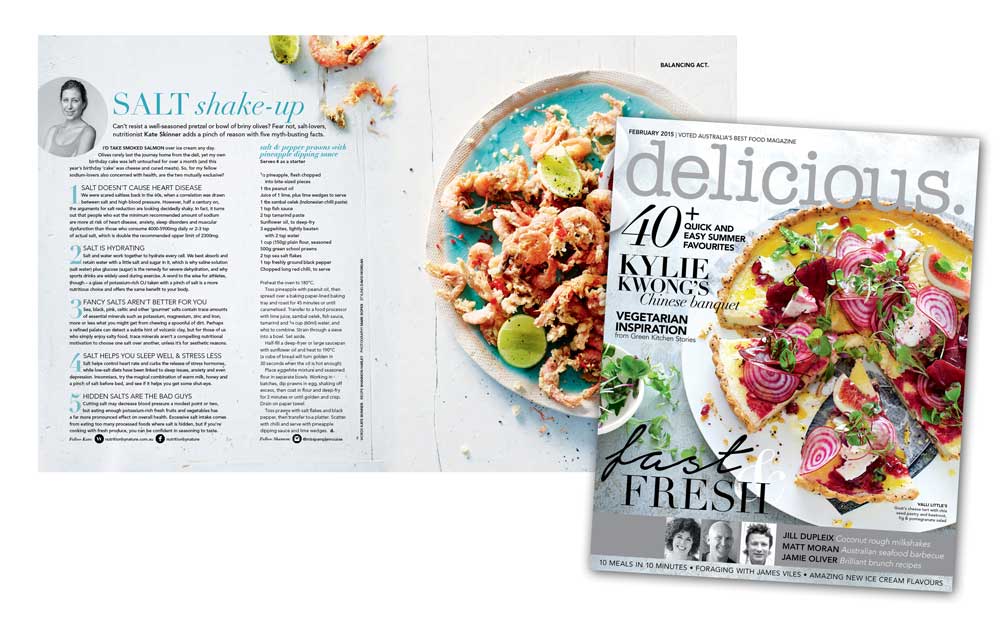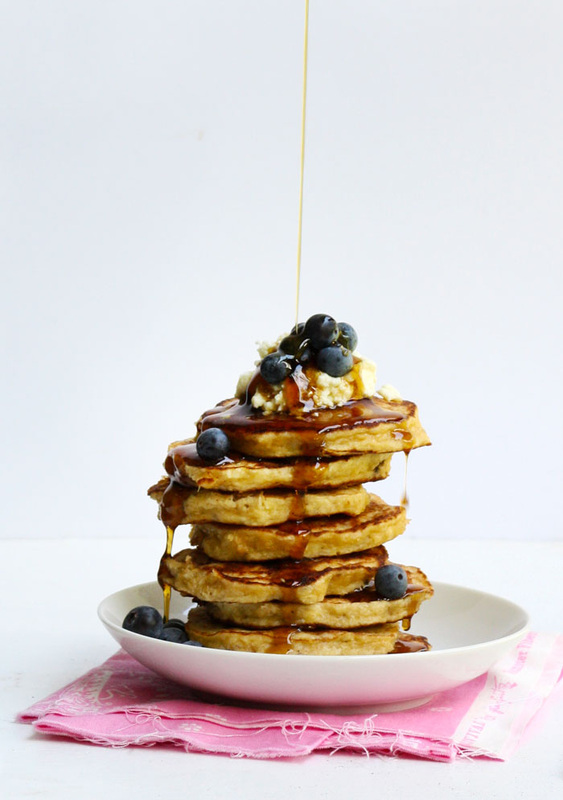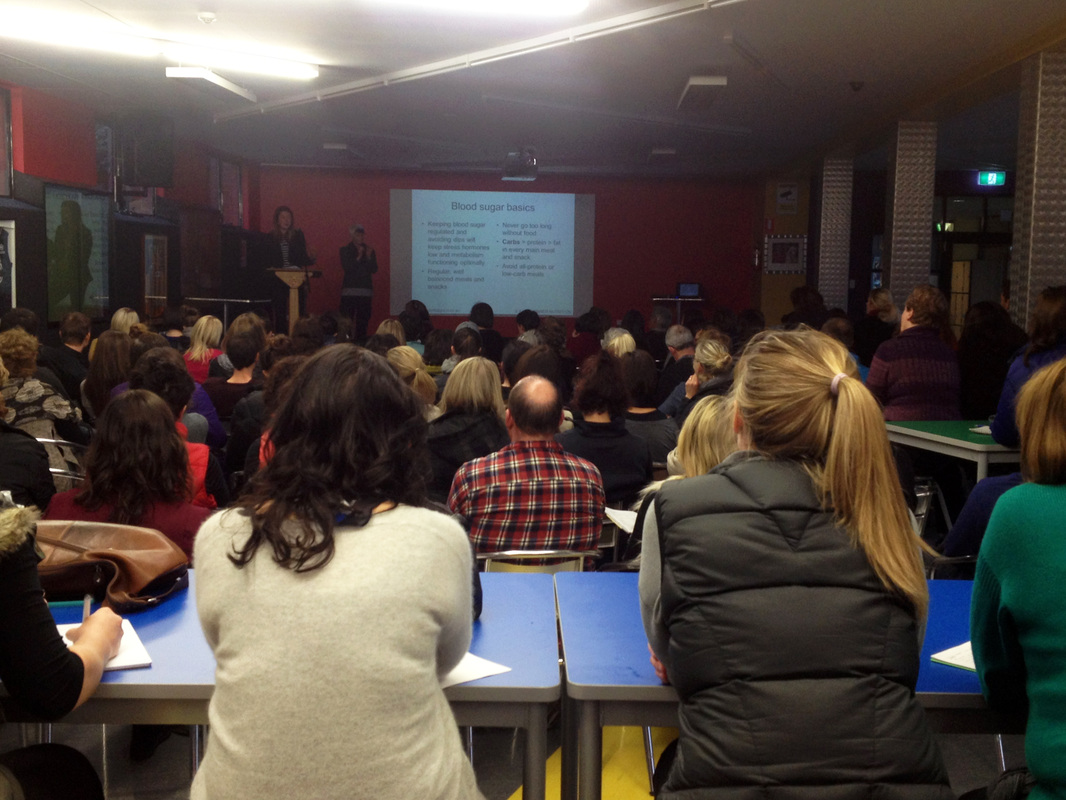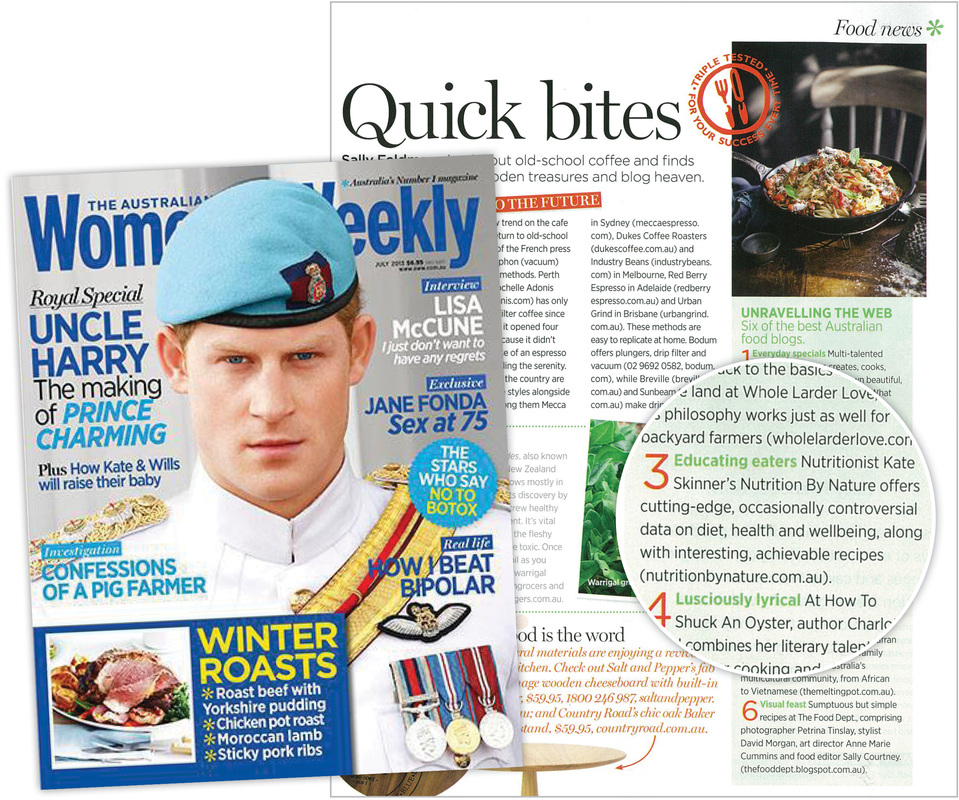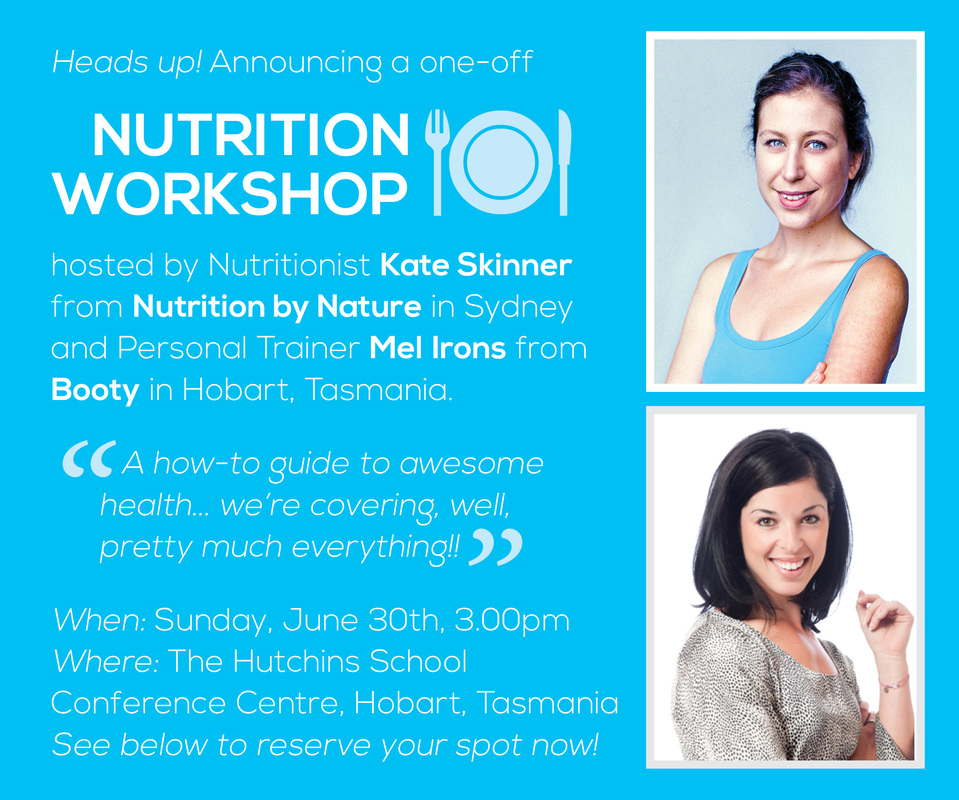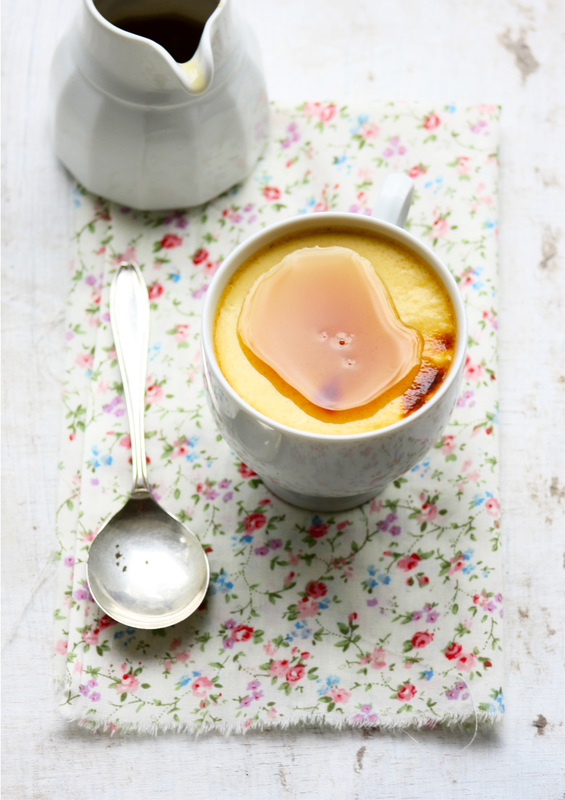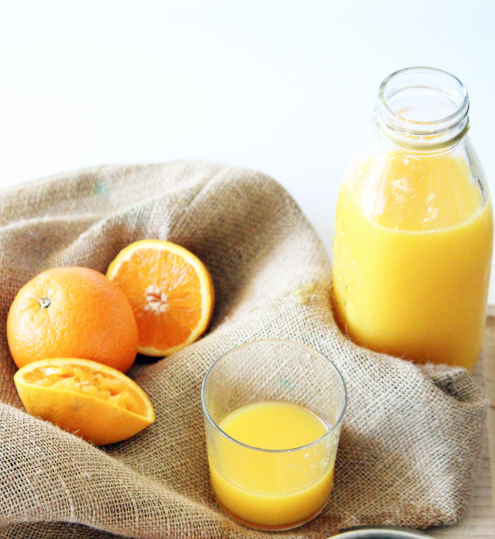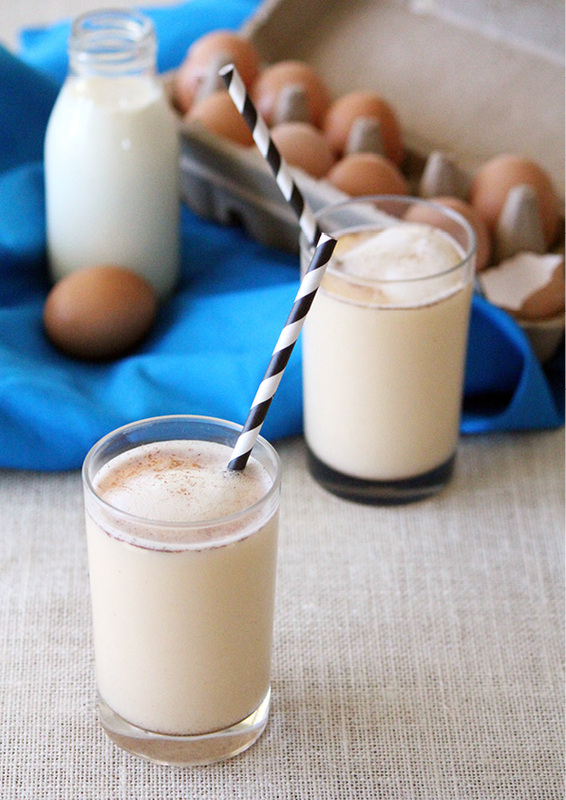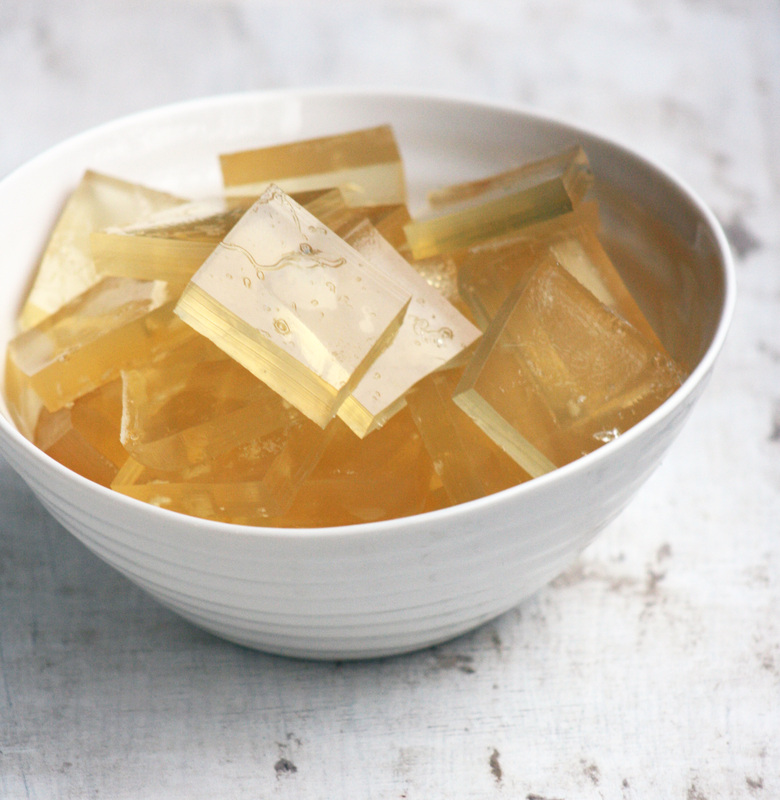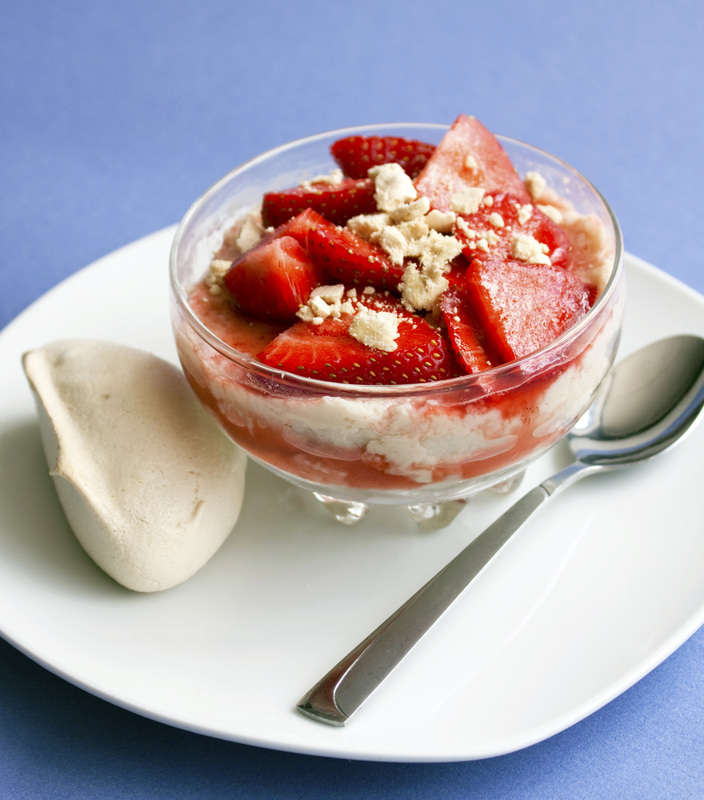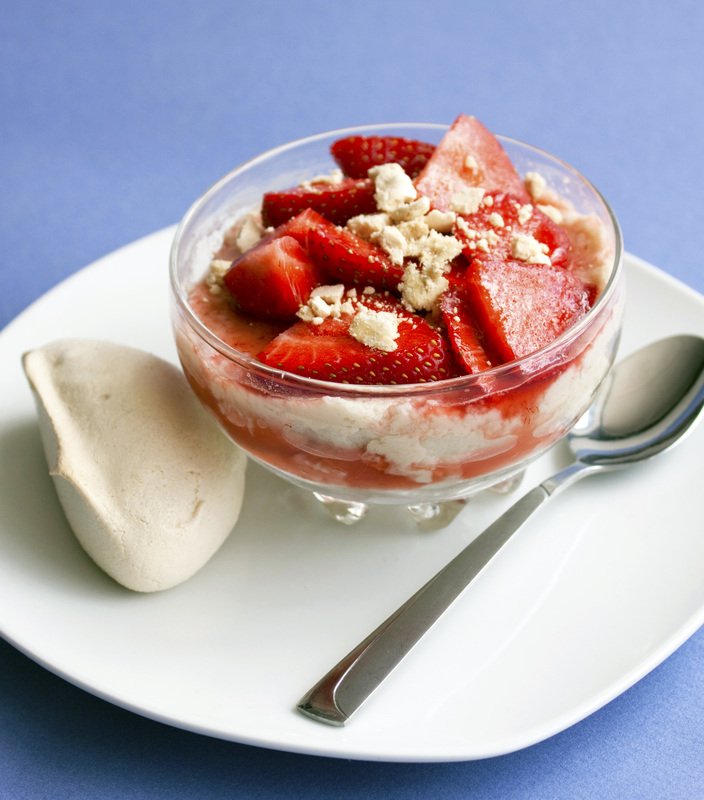For your monthly dose of no-nonsense nutritional advice, myth-busting and recipes, pick up a copy of delicious. magazine and flick over to my Balancing Act column. February's column sheds light on the myths and truths surrounding dietary salt, and explains why there's no need to be scared saltless. Enjoy!
]]>You wouldn't necessarily think it, but night time is actually quite a stressful time for the body. Whilst asleep, you essentially 'fast'. Levels of active thyroid hormone (T3) fall and stress hormones such as adrenaline and cortisol tend to peak, often kicking in as blood sugar drops*. So when you wake, your body is actually in a bit of a state of stress and, consequently, low metabolism (lowered thyroid function).
Skipping breakfast (or surviving on black coffee alone) only exacerbates this state. It's really important to get some food in first thing, to curb the stress response, boost metabolism, restock glycogen stores and effectively balance blood sugar from the get-go. Carbohydrates - including sugars - tick all these boxes (carbs restrain the release of stress hormones, facilitate the conversion of thyroid hormone to its active form thereby increasing metabolic rate, and can be utilized to restock glycogen stores), and a meal combining plenty of carbohydrates (such as starch, fruit, fresh fruit juice or natural sugar syrup) balanced with a bit of protein (dairy, eggs, etc) is ideal. Don't forget to include some sodium (salt) at breakfast too, another powerful anti-stress, pro-metabolic nutrient.
*Symptoms of low blood sugar, high nocturnal stress hormone activity and low metabolism/low thyroid include: waking during the early hours of the morning with a racing mind, rapid heartbeat and/or sweat (due to adrenaline peaking); waking once or more to urinate (the body literally 'sheds' water to conserve both salt and sugar); disturbed sleep patterns; and/or lack of appetite in the morning due to elevated levels of cortisol.
So. Pancakes!
Skipping breakfast (or surviving on black coffee alone) only exacerbates this state. It's really important to get some food in first thing, to curb the stress response, boost metabolism, restock glycogen stores and effectively balance blood sugar from the get-go. Carbohydrates - including sugars - tick all these boxes (carbs restrain the release of stress hormones, facilitate the conversion of thyroid hormone to its active form thereby increasing metabolic rate, and can be utilized to restock glycogen stores), and a meal combining plenty of carbohydrates (such as starch, fruit, fresh fruit juice or natural sugar syrup) balanced with a bit of protein (dairy, eggs, etc) is ideal. Don't forget to include some sodium (salt) at breakfast too, another powerful anti-stress, pro-metabolic nutrient.
*Symptoms of low blood sugar, high nocturnal stress hormone activity and low metabolism/low thyroid include: waking during the early hours of the morning with a racing mind, rapid heartbeat and/or sweat (due to adrenaline peaking); waking once or more to urinate (the body literally 'sheds' water to conserve both salt and sugar); disturbed sleep patterns; and/or lack of appetite in the morning due to elevated levels of cortisol.
So. Pancakes!
Banana, ricotta and coconut pancakes
Serves 4
1 cup self-raising flour
½ cup desiccated or shredded coconut
1 tsp bicarb of soda
Pinch salt
1 egg
½ cup mashed banana (from ~1 medium banana)
100g ricotta, plus extra to serve
1 cup milk
25g butter
Maple syrup and blueberries, to serve
Sift flour into a mixing bowl and add desiccated coconut, bicarb of soda and salt. Whisk together egg, ricotta, banana and milk with a fork.
Make a well in the centre of the dry ingredients and add wet ingredients, stirring to combine and beating out any lumps as you go.
Heat a frying pan over medium-low heat and grease with butter. Pour ⅓ cup pancake batter into the pan to create one pancake (you may be able to cook 2 or 3 pancakes at a time depending on the size of your frying pan). Cook until bubbles appear on the surface of the pancake, then flip and cook for another 1-2 minutes until golden. Repeat to use up batter.
Serve with extra ricotta, blueberries and maple syrup.
1 cup self-raising flour
½ cup desiccated or shredded coconut
1 tsp bicarb of soda
Pinch salt
1 egg
½ cup mashed banana (from ~1 medium banana)
100g ricotta, plus extra to serve
1 cup milk
25g butter
Maple syrup and blueberries, to serve
Sift flour into a mixing bowl and add desiccated coconut, bicarb of soda and salt. Whisk together egg, ricotta, banana and milk with a fork.
Make a well in the centre of the dry ingredients and add wet ingredients, stirring to combine and beating out any lumps as you go.
Heat a frying pan over medium-low heat and grease with butter. Pour ⅓ cup pancake batter into the pan to create one pancake (you may be able to cook 2 or 3 pancakes at a time depending on the size of your frying pan). Cook until bubbles appear on the surface of the pancake, then flip and cook for another 1-2 minutes until golden. Repeat to use up batter.
Serve with extra ricotta, blueberries and maple syrup.
Kate is a certified Clinical Nutritionist and offers one-on-one coaching for clients in Sydney Australia, and internationally via Skype. Visit the nutrition services page to find out more about private coaching, and be sure to subscribe via email and follow the Nutrition by Nature Facebook page for blog updates, articles, nutrition tips, recipes and special offers.
Hello! Long time no blog - oops. It's been utter madness at Nutrition by Nature HQ although I hope to be getting back into the swing of things soon... expect more regular articles and Q&A posts in the not-too-distant future! Here are links to two recent pieces penned for taste.com.au:
As well, I'm chuffed to be mentioned in the pages of this month's The Australian Women's Weekly magazine. (Gleefully "cutting-edge, occasionally controversial" indeed!!)
As well, I'm chuffed to be mentioned in the pages of this month's The Australian Women's Weekly magazine. (Gleefully "cutting-edge, occasionally controversial" indeed!!)
Also in the works, based on the overwhelmingly positive feedback that's been coming in after last weekend's nutrition workshop in Hobart, Tasmania (thank you so much to the amazing Mel at Booty for rallying the troops and to all 120+ of you lovely people who attended!).
I'll be planning some more seminars over the coming months. I'm thinking Sydney... obviously... and will also potentially line up gigs in other Aussie cities as well. So for all Australian readers, if you'd like to attend a one-off workshop in your home town and are willing to drag along a bunch of your nearest and dearest (let's uproot old dietary dogma, smash a bunch of food myths and issue some no-nonense nutrition advice for stress-free healthy living, yeah?), shoot me an email so I know that you're keen. And for international followers based in exotic locations... Bora Bora, Maui, The Bahamas... I'm willing to drag myself over your way too so register your interest accordingly.
Just a few topics that we covered in the seminar over the weekend (not an exhaustive list):
- Metabolism 101 - interpreting the signs of low metabolism and taking care of your thyroid
- The importance of minimising 'stress', in all it's various guises
- Relax. It's just food
- Stop drowning your body in water!
- Salt myths and truths
- The dangers of polyunsaturated fats
- Why butter is better!
- Food specifics - protein, carbs and fats in perspective
- Blood sugar basics
- Eating nutrient-dense foods (but not exclusively!)
- Everyone loves to hate on sugar... but our bodies LOVE sugar!
- Knowing when to ease up on the veggies
- Soy milk, protein powders, green smoothies and flax seeds - fuhgeddaboudit... :S
- Biofeedback - tuning in and getting to know to your body
- Why you should potentially eat MORE and exercise LESS
- Intelligent exercise - myths about cardio and endurance training for weight loss
- Losing weight the (only) healthy way - working with your body, not against it
- Croissants are awesome and so is ice cream
- Why the perfect diet isn't conducive to good health
- Why dessert can be a GREAT idea
- Nutrition strategies for a good night's sleep
What people are saying...
"That session yesterday was bloody amazing. It's the best thing I've done for myself in years - I feel so much more in control of how to proceed with good health, and Kate was absolutely brilliant to listen to. Not only is she herself a picture of good health, her advice hits the right note deep down inside your gut - it's that feeling you trust that has been previously clouded by incessant incorrect and untrustworthy marketing messages about what we should and shouldn't eat for good health. Finally the clouds have parted."
"Kate you did a terrific job keeping 120 of us listening, concentrating and then thinking for two hours, well done. You were really well prepared and I enjoyed the little stories you told to push a point. It was different to any other talk I have listened to on nutrition; lots of common sense backed by obvious scientific research. There is no doubt in my mind keeping stress levels down is crucial for mental health and long term wellbeing. You are a natural presenter!"
"Just awesome!! Reaffirms some things I already know - eg protein shakes, coconut oil, gelatin, meats, polyunsatured fats but WOW about carb/dairy/salt/sugar in regards to being Pro-Thyroid - I have NEVER in my thyroid journey ever heard anyone refer to the thyroid in nutrition and it was so refreshing!!! Very happy I'll be enjoying some rice and potatoes with BUTTER a little more often now."
"That session yesterday was bloody amazing. It's the best thing I've done for myself in years - I feel so much more in control of how to proceed with good health, and Kate was absolutely brilliant to listen to. Not only is she herself a picture of good health, her advice hits the right note deep down inside your gut - it's that feeling you trust that has been previously clouded by incessant incorrect and untrustworthy marketing messages about what we should and shouldn't eat for good health. Finally the clouds have parted."
"Kate you did a terrific job keeping 120 of us listening, concentrating and then thinking for two hours, well done. You were really well prepared and I enjoyed the little stories you told to push a point. It was different to any other talk I have listened to on nutrition; lots of common sense backed by obvious scientific research. There is no doubt in my mind keeping stress levels down is crucial for mental health and long term wellbeing. You are a natural presenter!"
"Just awesome!! Reaffirms some things I already know - eg protein shakes, coconut oil, gelatin, meats, polyunsatured fats but WOW about carb/dairy/salt/sugar in regards to being Pro-Thyroid - I have NEVER in my thyroid journey ever heard anyone refer to the thyroid in nutrition and it was so refreshing!!! Very happy I'll be enjoying some rice and potatoes with BUTTER a little more often now."
Kate is a certified Clinical Nutritionist and offers one-on-one coaching for clients in Sydney Australia, and internationally via Skype or email. Visit the nutrition services page to find out more about private coaching, and be sure to subscribe via email and follow the Nutrition by Nature Facebook page for blog updates, articles, nutrition tips, recipes and special offers.
Any followers out there from the Apple Isle?? I'm excited to announce that I'll be popping down to Tassie to host a Nutrition Workshop/Education Session thanks to lovely Mel at Booty (gobooty.com.au). Mel's an award-winning group personal trainer and psychologist-in-the-making who I was in touch with recently about all things health and nutrition – now we're joining forces to get the word out to the masses!
A little bit about the event, what I'll be talking about, etc (from Mel), below. Details regarding registration at the end – I hope to see some of you there!
A little bit about the event, what I'll be talking about, etc (from Mel), below. Details regarding registration at the end – I hope to see some of you there!
Mel: "You will all notice I don’t blog that much about nutrition, food or weight loss on the Booty website. I don’t believe in diets, one-size-fits-all programs, giving up food groups, 12-week challenges, generic food plans, or anything like that. I like to work one-on-one with people to work out what they would like to improve with how they are eating, then we go from there. I like to focus on health and wellbeing rather than a ridiculous body fat percentage or the latest 5-2 fasting diet!
It is true that research comes out regularly, and then the food “rules” seem to change. It’s really hard to stay on top of everything. It is important to be able to access plenty of good quality information so you can make informed decisions about what you eat. I spend a lot of time working with people who are really, really confused, or who panic when I say the words “full-fat” or “bread”. There is a lot of confusion out there… I don’t blame anyone for being confused, because I am confused too!
I am not about fads, diets, or gimmicks (I do understand how seductive they are though!) – which is why I want to help educate you all about these things. I figure you get so much not-so-good information from else where, I would like to bring you some of the “good” stuff.
I have been in touch a lot with a lovely nutritionist from Sydney called Kate Skinner, who runs her own business called Nutrition By Nature (www.nutritionbynature.com.au). I first was attracted to Kate because she wrote a about why eating sugar is important. I liked the sound of that!
I like her for her balance, and the fact that she says things like “well, this food isn’t that great for you because of A, B, and C, but if you really like it, eat it!” I also like her for the fact that she acknowledges that no one has all the answers. But at least she can help us see one potential set of answers.
So, I am extremely excited to announce that I am flying Kate down to run a nutrition education session for anyone who is interested. It will be an opportunity to learn a few things about what we eat and its effect on our systems. It will be a chance to discuss the things you don’t understand, and to ask questions about all the things you are confused about. It won’t be a strict rulebook. It will just be food for thought, so to speak :)
Some of the topics on the menu:
- Why eating dessert can be a GREAT idea
- Dairy (and full-fat!) for the win!
- Gelatin – what is it? Why should you get it in? What to do with it?
- Why good ol' white potatoes rock!
- Pate and liver – superfoods
- Which oils to cook with, which to use cold, which to avoid
- Why you should banish the marg and get back on the butter
- The up-side of coffee-drinking and how to drink it to reap the benefits
- How thyroid function and metabolism affect body composition
- Is your metabolism in poor shape? How to read the warning signs... and what to do about it
- Sugar myths and truths (and why ‘quitting sugar’ is a terrible idea!)
- Why your body needs carbs (and what carbs even are!)
- The importance of avoiding low-calorie diets
- Why you should ditch the dieting mentality altogether
- Signs of a body in stress – how to tell, and how to avoid it
- The benefits of orange juice, honey, maple syrup and other natural sugars
- Red meat v. pork v. poultry – which meats to buy and why
- The 'whole grain myth'
- Quinoa – is it really all it’s cracked up to be?
- How to treat oats and grains to get the most out of them
- Choosing a bread to keep your gut happy
- Why cheesy croissants get the tick!
- The issues with consuming soy and soy products
- Beans, lentils, legumes and cruciferous veg – yay or nay?
- Why sometimes you should forgo the salad
- Why ‘overhydration’ (too much water-guzzling) can slow your metabolism
- The benefits and necessity of dietary salt
- Artificial sweeteners v. using real sugar
- How to exercise wisely to avoid harming your metabolism
- Ageing gracefully
- Supporting good skin health
- Meal planning and snack ideas
- Q & A… ask away!
Who should attend?
Well I think everyone should come! You are guaranteed to learn a lot and have some of your preexisting ideas challenged (croissant, anyone?), and some of your questions answered.
For many of you, I know your first reaction will be “Looks interesting! Cool. Count me in!” OR it will be “Na, not interested. No thanks!” Cool.
For others their first response will be different. Did the thought of this education session cause some hesitation for you? Did reading all this bring up some real barriers or negativity? Chances are high it is because you have had a somewhat unhealthy relationship with food in the past, some sort of disordered eating, a history of dieting. And when I say disordered eating – I am not just talking about anorexia and bulimia here. 50% of “disordered eating” cases are known as EDNOS – “eating disorder not otherwise specified”. Disordered eating comes in so many different forms, and most people don’t ever get treatment. For these people, this stuff looks new, different, scary, or wrong. It is because they like rules.
The way Kate teaches is that it is not about rules. It is about exactly the opposite – which is why many people who have had disordered eating/a history of dieting will find a lot of this stuff uncomfortable. Come for a listen anyway. You don’t have to put ANY of this stuff in place if you don’t want to later. And please talk to me if you have any concerns at all.
Kate will talk a lot about metabolism, stress hormones and thyroid function, which means of course weight loss will be discussed in detail, but she is not all about weight loss. It’s about being healthy and feeling well.
I am sure you will all pick up something interesting. Some of you will learn heaps. It is really just all about nutrition education! Presented by a cool young chick!
Where?
The education session will be at the Hutchins School Conference Centre in Hobart, Tasmania on Sunday June 30th (2:45pm for a 3pm start, until approximately 5pm). You can see which building the Conference Centre is below – it is opposite the Hutchins School Gym. I would suggest park on Churchill Avenue, and walk down the driveway between the Gym and the Boarding House.
Kate will also be hanging around afterwards to chat to you individually if you have questions!
What's the cost?
I am charging $30 per person for this, which is the absolute minimum I can charge to cover expenses, such as paying Kate for her valuable time, and her trip down. I think this is extremely cheap. Seeing a nutritionist for an initial one-on-one hour-long consultation would cost you around $120.00. I am very confident you will get quite a lot out of this and that this is excellent value for money (or I would not be flying her down).
How do I sign up?
You must put in this form as soon as possible, as I will need to know numbers asap to make sure we will fit!
This is of course open to everyone. Go right ahead and spread the word!"
Public health guidelines, food pyramids and plates, high-fat, low-carb, vegan, vegetarian, low-GI, high-protein, low-sugar, low-fat, low-cholesterol, Paleo, Atkins, fruitarian, alkaline, blood type diets, raw foods, fasting, cleanses, detoxes… it’s a minefield of weird and wacky, contradictory nutritional information and dietary advice out there. Most of it is utter nonsense.
We’re inundated with opinions, pushed and pulled in every direction and at the end of the day, more confused about what to eat than ever. When it comes to looking at nutrition from a physiological perspective, for the individual person in the context of the modern world, I personally disagree with the majority of what the mainstream deems to be “healthy”. The foods and specific nutrients that end up being most conducive to a well-primed metabolism would surprise you.
We’re inundated with opinions, pushed and pulled in every direction and at the end of the day, more confused about what to eat than ever. When it comes to looking at nutrition from a physiological perspective, for the individual person in the context of the modern world, I personally disagree with the majority of what the mainstream deems to be “healthy”. The foods and specific nutrients that end up being most conducive to a well-primed metabolism would surprise you.
For every good study, there are at least 10 pretty mediocre ones – poorly planned, with uncontrolled variables, small cohort, observational, commercially swayed, etc. For each one of these, there’s dozens of sensationalized media headlines that further compound the confusion. One study that correlates dietary animal fats with heart disease incidence might just as well equate wearing blue jeans with ill health by the same tunnel-visioned logic. The thing is, there’s a million other uncontrolled variables at play. Correlation does not equal causation.
Most health ‘recommendations’ don’t solely have the interests of the individual at heart, or even hard science, for that matter. There tend to be other competing factors involved – marketing, profit, popularity, maintaining current opinions, etc. it’s worth keeping this in mind when you’re evaluating the latest ‘detox’ program, supplement, fitness regime or popular diet – consider where the information is coming from and why, and question accordingly.
The same goes for food labeling. A “gluten-free”/”organic”/”natural” sticker doesn’t necessarily correlate with any increased nutritional benefit of attached food products (although such labels seem to align proportionally with cost, as a rule).The same applies to foods and products touted as “wholegrain”/ “low-GI”/“low-fat”/“sugar-free”/ “vegetable-based”/“Heart Foundation approved” – don’t make the mistake of assuming these terms are synonymous with what’s best for your body. I have seen “health” foods and products, in popular health food shops and aisles, that are some of the worst offenders out there. Generally, the most optimal foods don’t need fancy health claims.
L-i-s-t-e-n to your body. If you’re legitimately craving salt or sugar (gasp!) but avoiding sweet and salty foods like the plague, question the physiological reasons for your natural cravings. If you’re loading up on supplements in your quest for nutritional nirvana then you might want to think about if and/or what your diet is actually lacking, and whether it’s possible to correct any issues without popping a nutriceutical (or many). Really want to jump on the ‘detox’ bandwagon? Educate yourself about how your liver functions to naturally ‘detoxify’ the body each and every day, without the need for some wacky cleansing routine (besides, going on a ‘detox’ suggests an initial ‘tox’ or post-detox ‘retox’, no?). If you’re choking down vast quantities of Brussels sprouts and broccoli daily because of their on-paper nutritional profiles, at the cost of a whole lot of digestive grief, maybe, just maybe, they’re not the best foods for you. Trust your gut – quite literally!
Even for the dedicated health nuts and health experts, to quote Mark Twain, “don’t let your education get in the way of your learning”. Scientific progress isn’t made without questioning and critically evaluating the status quo.
Question everything (including me).
]]>Most health ‘recommendations’ don’t solely have the interests of the individual at heart, or even hard science, for that matter. There tend to be other competing factors involved – marketing, profit, popularity, maintaining current opinions, etc. it’s worth keeping this in mind when you’re evaluating the latest ‘detox’ program, supplement, fitness regime or popular diet – consider where the information is coming from and why, and question accordingly.
The same goes for food labeling. A “gluten-free”/”organic”/”natural” sticker doesn’t necessarily correlate with any increased nutritional benefit of attached food products (although such labels seem to align proportionally with cost, as a rule).The same applies to foods and products touted as “wholegrain”/ “low-GI”/“low-fat”/“sugar-free”/ “vegetable-based”/“Heart Foundation approved” – don’t make the mistake of assuming these terms are synonymous with what’s best for your body. I have seen “health” foods and products, in popular health food shops and aisles, that are some of the worst offenders out there. Generally, the most optimal foods don’t need fancy health claims.
L-i-s-t-e-n to your body. If you’re legitimately craving salt or sugar (gasp!) but avoiding sweet and salty foods like the plague, question the physiological reasons for your natural cravings. If you’re loading up on supplements in your quest for nutritional nirvana then you might want to think about if and/or what your diet is actually lacking, and whether it’s possible to correct any issues without popping a nutriceutical (or many). Really want to jump on the ‘detox’ bandwagon? Educate yourself about how your liver functions to naturally ‘detoxify’ the body each and every day, without the need for some wacky cleansing routine (besides, going on a ‘detox’ suggests an initial ‘tox’ or post-detox ‘retox’, no?). If you’re choking down vast quantities of Brussels sprouts and broccoli daily because of their on-paper nutritional profiles, at the cost of a whole lot of digestive grief, maybe, just maybe, they’re not the best foods for you. Trust your gut – quite literally!
Even for the dedicated health nuts and health experts, to quote Mark Twain, “don’t let your education get in the way of your learning”. Scientific progress isn’t made without questioning and critically evaluating the status quo.
Question everything (including me).
Maple custards
Serves 2
1.5 cups milk
2 eggs
1/3 cup maple syrup
1 tsp vanilla bean extract
pinch salt
Preheat oven to 190ºC. Place two 1-cup capacity ramekins into a large baking dish and set aside (if you don’t have ramekins, small jars or teacups are fine).
In a small saucepan, heat the milk until just below boiling point. Turn off the heat.
In a large bowl, whisk the eggs, maple syrup, vanilla and salt. Add the hot milk in a steady stream, whisking continuously. Let the mixture stand for a couple of minutes. If any foam rises to the surface, skim it off with a spoon, then divide the mixture between your ramekins.
Make a water bath by pouring hot water into the baking dish so that it comes at least halfway up the sides of your ramekins (water from a recently boiled kettle is ideal). Carefully transfer to the oven and bake for 30-45 minutes, or until just set.
1.5 cups milk
2 eggs
1/3 cup maple syrup
1 tsp vanilla bean extract
pinch salt
Preheat oven to 190ºC. Place two 1-cup capacity ramekins into a large baking dish and set aside (if you don’t have ramekins, small jars or teacups are fine).
In a small saucepan, heat the milk until just below boiling point. Turn off the heat.
In a large bowl, whisk the eggs, maple syrup, vanilla and salt. Add the hot milk in a steady stream, whisking continuously. Let the mixture stand for a couple of minutes. If any foam rises to the surface, skim it off with a spoon, then divide the mixture between your ramekins.
Make a water bath by pouring hot water into the baking dish so that it comes at least halfway up the sides of your ramekins (water from a recently boiled kettle is ideal). Carefully transfer to the oven and bake for 30-45 minutes, or until just set.
You could serve these hot or cold, for dessert or for breakfast - I like a bit of custard as a bedtime snack.
- Calcium in milk reduces stress, is extremely pro-metabolic and decreases levels of parathyroid hormone, which can play a role in insomnia.
- The added sugar - maple syrup - and salt further increase the pro-sleep effect by helping to boost T3 and body temperature, replenish liver glycogen stores and curb the release of nocturnal stress hormones adrenaline and cortisol.
| Kate is a certified Clinical Nutritionist and offers one-on-one coaching for clients in Sydney Australia, and internationally via Skype or email. Visit the nutrition services page to find out more about private coaching, and be sure to subscribe via email and follow the Nutrition by Nature Facebook page for blog updates, articles, nutrition tips, recipes and special offers. |
| Today, instead of answering a specific question (or a few) I thought I’d respond to requests that have come in via email for snack suggestions. It seems like the majority of people have their main meals pretty well down pat, but struggle for snack ideas. Particularly in a low metabolic state (indicated by low waking body temperature – <36.6ºC/97.8ºF – and pulse outside of normal range), snacks can be useful for balancing blood sugar between meals, minimising the release the release of stress hormones and increasing thyroid. When metabolism is optimal, you may find that you are able to go between main meals without signs of low blood sugar (cravings, low energy, irritability, headaches, anxiety, frequent urination, etc). I would encourage you, however, to avoid relying on countless snacks all day and ensure you get in proper 3x squares. Regular, hearty and well-balanced meals (breakfast, lunch and dinner) encourage mindful eating, better digestion and greater post-prandial satiety. Even better, if you can put a little |
time and effort into preparing delicious, nutrient-dense meals, and savour them in good company, you’re more likely to feel truly satisfied both physically and emotionally by the food on your plate.
A few of the below ideas were favourites from my previous snacky post (fruit + cheese will never get old!), some are updated and tweaked, and some are new. Here goes…
A few of the below ideas were favourites from my previous snacky post (fruit + cheese will never get old!), some are updated and tweaked, and some are new. Here goes…
Ripe fruit + cheese. Nutrient-dense and satiating, the fruit and cheese combo provides a the perfect balance of natural sugar, salt, saturated fat and protein (with calcium, as a bonus) to curb the release of inflammatory stress hormones, mediate blood sugars and optimize metabolism by supporting good thyroid health. There’s a reason it’s my favourite! Try grapes + cheddar, watermelon + feta, pineapple + cottage cheese, cherries + ricotta, ripe figs + blue cheese, pear + parmesan or stone fruit + bocconcini.
A boiled egg + fruit. Eggs provide a wealth of hard-to-get nutrients, including choline for proper fat assimilation and cholesterol metabolism, and preformed vitamin A required for the synthesis of protective hormones such as progesterone, proper cellular differentiation, immune function, skin, hair, and eye health. In a low metabolic state, liver conversion of pre-vitamin A, betacarotene (from carrots, sweet potatoes, etc), to true vitamin A is poor, so it’s important to consume preformed vitamin A from animal sources like eggs, liver and dairy. Salt your egg well and eat it alongside a piece of ripe fruit or a glass of fresh orange juice (eating protein alone will only perpetuate low blood sugar and increase the release of stress hormones).
Dark chocolate. Go for it. Nibbling on a few squares of dark chocolate (20-35g) between meals can help keep blood sugars in good range, supply the body with pro-thyroid minerals such as magnesium, healthy saturated fat and digestible sugar. See here for recommended brands or make your own coconut oil chocolate with sea salt and chilli.
| Orange juice + hydolyzed gelatin. Of course, I’ve banged on about the benefits of consuming gelatin before (too many times to count now!). The natural sugars in fresh orange juice plus glycine-rich gelatin is a metabolism-supporting, stress-busting snack – even more so if a pinch of salt is added to the mix (don’t knock it until you’ve tried it). I often suggest this concoction for use pre- and post-exercise (and sometimes even during), to immediately draw down cortisol, which naturally rises during a work out and can inhibit metabolism if not abated with a little sugar and salt. For proper hydration, these two nutrients (sodium and simple sugar) are essential – salted juice is actually more hydrating than guzzling lots of plain water (which many people tend to overdo). |
Raw carrot salad. Carrot fibres are antimicrobial and excellent for preventing build-up of bacterial endotoxin and clearing our the lower bowel. Grate one carrot into a bowl, add 1-2 tsp coconut oil and a little vinegar, herbs, red onion and salt, to taste. For the time-poor (or lazy, like me) just nosh on a raw carrot, Bugs Bunny-style.
Leftovers. A small piece of fish with a few slices of cooked sweet potato, a little leftover meat and root veg, home-made curry, stir-fry, root vegetable soup, etc. Small servings of leftovers from home-cooked meals can make for the most satisfying and nutritious snacks, and tend to be fairly well-balanced options in terms of providing good amounts of all your macronutrients.
Greek yoghurt + honey. A bowl of high quality (full-fat) Greek yoghurt topped with a drizzle of raw honey or maple syrup is super easy and delicious. Add cinnamon or ground nutmeg for spice.
Olives. Choose quality olives preserved in extra virgin olive oil or brine (never canola or sunflower oil, or any other cheap polyunsaturated oil). Try plain Kalamatas or large green olives stuffed with sheep’s milk feta, eaten alongside a few handfuls of raw capsicum, carrot sticks and/or slices of ripe pear.
Frittata. Sliced potato with rosemary, zucchini and roast tomatoes is a favourite combination of mine in an egg frittata or Spanish tortilla. It’s all too easy to cook up a big frittata on the weekend and cut it into slices ready to go for meals and snacks during the week. You can even freeze the portions and defrost/reheat them as you need – great served cold or warm.
Bone broth. A cup of well-prepared bone broth (stock) makes a brilliant snack and an easy way to get glycine into your diet. Add some sweet cooked beets, sea salt and fresh herbs – it will win you over. Read more on the benefits of bone stock here.
Macadamia nuts. I’m not a fan of nuts due to their high polyunsaturated fat content and poor digestibility (read all about it in this post), but our own Aussie macadamias are a better choice than all other nuts as they are uniquely high in monounsaturated fat and low in PUFA. For the sweet-toothed among us, they’re lovely dipped in a little melted and salted dark chocolate (allow to cool on a sheet of baking paper) – consider yourself warned though, they’re easy to overindulge on!
A small baked potato. Bake well-seasoned sweet or white potatoes for at least 40 minutes (I bake extras, whenever I’m cooking them) and enjoy hot or cold with a dollop of natural yoghurt or a little grated cheese and a sprinkling of herbs, dried chilli and spices – whichever tickle your fancy. Potatoes are incredibly satiating and an excellent thermogenic food, great for boosting core body temperature and metabolic rate.
Leftovers. A small piece of fish with a few slices of cooked sweet potato, a little leftover meat and root veg, home-made curry, stir-fry, root vegetable soup, etc. Small servings of leftovers from home-cooked meals can make for the most satisfying and nutritious snacks, and tend to be fairly well-balanced options in terms of providing good amounts of all your macronutrients.
Greek yoghurt + honey. A bowl of high quality (full-fat) Greek yoghurt topped with a drizzle of raw honey or maple syrup is super easy and delicious. Add cinnamon or ground nutmeg for spice.
Olives. Choose quality olives preserved in extra virgin olive oil or brine (never canola or sunflower oil, or any other cheap polyunsaturated oil). Try plain Kalamatas or large green olives stuffed with sheep’s milk feta, eaten alongside a few handfuls of raw capsicum, carrot sticks and/or slices of ripe pear.
Frittata. Sliced potato with rosemary, zucchini and roast tomatoes is a favourite combination of mine in an egg frittata or Spanish tortilla. It’s all too easy to cook up a big frittata on the weekend and cut it into slices ready to go for meals and snacks during the week. You can even freeze the portions and defrost/reheat them as you need – great served cold or warm.
Bone broth. A cup of well-prepared bone broth (stock) makes a brilliant snack and an easy way to get glycine into your diet. Add some sweet cooked beets, sea salt and fresh herbs – it will win you over. Read more on the benefits of bone stock here.
Macadamia nuts. I’m not a fan of nuts due to their high polyunsaturated fat content and poor digestibility (read all about it in this post), but our own Aussie macadamias are a better choice than all other nuts as they are uniquely high in monounsaturated fat and low in PUFA. For the sweet-toothed among us, they’re lovely dipped in a little melted and salted dark chocolate (allow to cool on a sheet of baking paper) – consider yourself warned though, they’re easy to overindulge on!
A small baked potato. Bake well-seasoned sweet or white potatoes for at least 40 minutes (I bake extras, whenever I’m cooking them) and enjoy hot or cold with a dollop of natural yoghurt or a little grated cheese and a sprinkling of herbs, dried chilli and spices – whichever tickle your fancy. Potatoes are incredibly satiating and an excellent thermogenic food, great for boosting core body temperature and metabolic rate.
| Potato pancakes. On the topic of the humble spud, my potato pancakes provide a nice balance of warming starch, protein (egg – in the pancake batter) and salt. Keep a cooked batch or leftovers in the fridge and enjoy the pancakes plain as a quick snack (they’re equally good served hot or cold). Pâté. Liver is arguably the most nutrient-dense food available to us and can be used as a potent multimineral and multivitamin ‘supplement’. Albeit, liver can be a little hard to stomach for the initiated, so pâté is a brilliant way to get in this true superfood. Choose a quality pâté (preferably organic) made with natural butter, herbs and salt, and serve with some vegetable crudités or a slice of proper sourdough. If you’re up for making your own, simply panfry onions and liver until browned, then blend with salt, fresh herbs and butter. |
Young coconut. Seek out a young (green) coconut and crack it open to source fresh coconut water. When you’re done drinking, scoop out the soft flesh of the coconut for a mineral-rich, tropical snack.
Coconut macaroons. Store-bought varieties can contain lots of additives, but macaroons really easy to make yourself just by combining coconut flakes or desiccated coconut, a few spoons of honey and good quality egg white/s (save the yolks for a smoothie or dessert – don’t chuck those beauties!) and baking in a low-heat oven until firm and chewy.
Sushi. An easy takeaway option if you’re on-the-fly. I tend to go for raw tuna (low in polyunsaturated fatty acids) or cooked prawns (shellfish is a great source of pro-thyroid micronutrients and protein), nicely balanced with easily-digested starch in the form of white rice. You could do the same combination in a fresh (not fried) Vietnamese rice paper roll if preferred.
A fruit smoothie. Blend fresh fruit with milk/goat's milk/yoghurt/coconut milk and a little ice. If you’re game, add an egg yolk for the extra fat-soluble nutrients and protein, or stick with traditional add-ins like cocoa powder, cinnamon, untreated honey or fresh mint.
Sweet potato chips. Completely addictive. Simply cut a sweet potato into wedges or thin discs and shallow fry in a little butter or coconut oil, before draining on paper towel and tossing with herbs or cinnamon and sea salt. Serve with a little pure sour cream if you like. Alternatively, cut into thick-cut chips or wedges, rub with a little coconut oil or beaten egg, season well and bake in a hot oven for 20-30 minutes until crisp.
Coconut macaroons. Store-bought varieties can contain lots of additives, but macaroons really easy to make yourself just by combining coconut flakes or desiccated coconut, a few spoons of honey and good quality egg white/s (save the yolks for a smoothie or dessert – don’t chuck those beauties!) and baking in a low-heat oven until firm and chewy.
Sushi. An easy takeaway option if you’re on-the-fly. I tend to go for raw tuna (low in polyunsaturated fatty acids) or cooked prawns (shellfish is a great source of pro-thyroid micronutrients and protein), nicely balanced with easily-digested starch in the form of white rice. You could do the same combination in a fresh (not fried) Vietnamese rice paper roll if preferred.
A fruit smoothie. Blend fresh fruit with milk/goat's milk/yoghurt/coconut milk and a little ice. If you’re game, add an egg yolk for the extra fat-soluble nutrients and protein, or stick with traditional add-ins like cocoa powder, cinnamon, untreated honey or fresh mint.
Sweet potato chips. Completely addictive. Simply cut a sweet potato into wedges or thin discs and shallow fry in a little butter or coconut oil, before draining on paper towel and tossing with herbs or cinnamon and sea salt. Serve with a little pure sour cream if you like. Alternatively, cut into thick-cut chips or wedges, rub with a little coconut oil or beaten egg, season well and bake in a hot oven for 20-30 minutes until crisp.
| An all-natural protein shake (egg flip). Infinitely better for you than any store-bought protein powder, shake or bar, nutrient-rich and completely delicious. See this post for the recipe (pictured). Yoghurt-dipped banana bites. If you’ve got a little prep time and get organised in advance, make a batch of yummy banana bites by dipping pieces of banana (or other fruit) in Greek yoghurt, placing on a sheet of baking paper or tray and freezing until the yoghurt coating is firm. Enjoy straight from the freezer. Baked apple. Just core and halve an apple (any kind), rub with a dab of butter or coconut oil, sprinkle with cinnamon and bake in a hot oven until cooked through and a little soft. Serve with a spoon or two of full-fat Greek yoghurt, cottage or ricotta cheese. You could really sub any fruit you like too – plums, persimmons, nectarines, peaches and pears all work well. |
Roast beef. I like to keep leftover slices of rare roast beef in the fridge as an easy (portable) snack or meal option – just pair with some kind of carbohydrate like a little leftover cooked pumpkin, beets, a piece of fruit or a good handful of capsicum (eating protein alone will only perpetuate low blood sugar and increase the release of stress hormones). It's also a good idea to balance the amino acid profile of muscle meats with pro-thyroid amino acids that aren't as readily found in our diets, like glycine and proline from gelatine and broth.
Capsicum and herbed cream cheese. Mix a little home-made or good quality store-bought cream cheese (the real stuff - no "low-fat" or "light" processed versions please) with chopped chives, parsley or dill, season and spread over thick slices of fresh capsicum (bell pepper) to serve. For a sweet version, mix plain cream cheese with a touch of honey and spread over slices of fresh fruit or a piece of toasted sourdough bread.
Ricotta-stuffed dates. Easy and delicious, I like to add a small pinch of salt to bring out the sweetness of the fruit and provide that great stress-busting, hormone-balancing, thyroid-boosting sugar/salt combination. Don’t like dates? Substitute unsulfured dried apricot halves or figs.
Warm milk + honey. Who doesn’t love a warm cup of milk with honey? Add chai spices (cinnamon, cloves, star anise, ginger, etc) and sea salt for a beautiful snack that’s soothing to the adrenal glands, pro-metabolic and anti-stress (although you may just want to curl up and nod off afterwards!).
Hot cocoa. Another warming, nutrient-dense drink to enjoy on a chilly afternoon. Just warm a cup of milk of your choice (goat's milk, cow's milk, or go half and half coconut milk/water) with a heaped spoon of high quality cocoa powder, pinch of salt, dash of vanilla extract and honey, to taste. You could add a spoon of hydrolyzed gelatin too, if you like, which will blend in well and increase the nutrient value and protein.
Capsicum and herbed cream cheese. Mix a little home-made or good quality store-bought cream cheese (the real stuff - no "low-fat" or "light" processed versions please) with chopped chives, parsley or dill, season and spread over thick slices of fresh capsicum (bell pepper) to serve. For a sweet version, mix plain cream cheese with a touch of honey and spread over slices of fresh fruit or a piece of toasted sourdough bread.
Ricotta-stuffed dates. Easy and delicious, I like to add a small pinch of salt to bring out the sweetness of the fruit and provide that great stress-busting, hormone-balancing, thyroid-boosting sugar/salt combination. Don’t like dates? Substitute unsulfured dried apricot halves or figs.
Warm milk + honey. Who doesn’t love a warm cup of milk with honey? Add chai spices (cinnamon, cloves, star anise, ginger, etc) and sea salt for a beautiful snack that’s soothing to the adrenal glands, pro-metabolic and anti-stress (although you may just want to curl up and nod off afterwards!).
Hot cocoa. Another warming, nutrient-dense drink to enjoy on a chilly afternoon. Just warm a cup of milk of your choice (goat's milk, cow's milk, or go half and half coconut milk/water) with a heaped spoon of high quality cocoa powder, pinch of salt, dash of vanilla extract and honey, to taste. You could add a spoon of hydrolyzed gelatin too, if you like, which will blend in well and increase the nutrient value and protein.
| Home-made jelly. Again, a wonderful way to include gelatin in your diet – see here for a recipe for firm jube-like jellies (pictured above), or use normal gelatin ratios (1 tbs powdered gelatin to 500 ml liquid) to make spoonable jelly flavoured with fresh fruit juice or honey-sweetened milk. Your digestive tract, skin, hair and nails will thank you. |
Kate is a registered Clinical Nutritionist and offers one-on-one coaching for clients in Sydney Australia, and internationally via Skype or email. Visit the nutrition services page to find out more about private coaching, and be sure to subscribe via email and follow the Nutrition by Nature Facebook page for blog updates, articles, nutrition tips, recipes and special offers.
Becca asks, via email: “Any tips/recipes/advice on a no rubbish DIY protein shake? I see all these giant tubs of scary powder lining shelves and it makes me feel a bit sad. Something for those mornings where the stove just feels too daunting, or post-work out when my silly brain says to me 'don't eat yet!'”
The companies that market those giant tubs of protein powders are advertising masterminds. I mean, beside the fact that these powders are the ultra-processed, chemically-extracted, ground down waste products of various industries and taste like stevia-sweetened sweaty socks, think about it: the exact same product that is marketed to men for “bulking up” is sold to us ladies as being “slimming”.
Hence soy, whey and rice protein powders are all very popular, but what we aren’t told is that each one of these detracts more from overall health than it gives. In the long run, they can cause widespread inflammation in the body, inhibit optimal metabolism (contributing to weight gain, not loss), cause hormonal imbalance and digestive grief.
- Soy protein powders are probably the worst offenders, as soy is a potent thyroid inhibitor and endocrine disruptor. Avoid, avoid, avoid.
- Whey powders tends to contain an excess of tryptophan, which is anti-thyroid and inflammatory (when not balanced with anti-inflammatory, pro-thyroid amino acids such as glycine, from gelatin), and potentially even carcinogenic.
- Rice protein powders are heavily processed (they all are), not particularly high in bioavailable protein, generally too high in bran fibre (mineral-binding and irritating to the gut) and polyunsaturated fatty acids.
So, are there better options? YES!! Here are two:
- An all-natural “protein shake” (egg flip) – which takes just a few shakes to put together, tastes amazing, is incredibly nutrient-dense, provides a balanced spectrum of amino acids and probably the most bioavailable protein you can ingest, will help to lower stress hormones and promote optimal metabolism. Recipe below.
- Hydrolyzed gelatin powder* – for those who still want a “protein powder” (especially a portable one). Add a spoonful to fresh orange juice (the sugar balances blood sugar, and lowers cortisol and adrenaline) with a pinch of salt (also anti-stress, and essential for optimal hydration) and baking soda (helps to increase protective carbon dioxide, reduce water retention/oedema and support good cellular metabolism). It’s the only “protein powder” I’d recommend, as gelatin is naturally low in anti-thyroid amino acids, and high in anti-inflammatory glycine and proline – read more about gelatin here.
All-natural "protein shake" (egg flip)
Serves 1
1 raw whole egg or egg yolk
1 cup cold milk
1-2 tbs runny honey
½ tsp cinnamon
ice cubes, to serve (optional)
Combine all ingredients and blend or whisk until (very) well combined. Alternatively, place ingredients in a sealable container, jar or bottle, seal and shake well until combined. Serve over ice.
Some additional notes:
1 raw whole egg or egg yolk
1 cup cold milk
1-2 tbs runny honey
½ tsp cinnamon
ice cubes, to serve (optional)
Combine all ingredients and blend or whisk until (very) well combined. Alternatively, place ingredients in a sealable container, jar or bottle, seal and shake well until combined. Serve over ice.
Some additional notes:
- Carbohydrates are “protein-sparing”, required for optimizing metabolism and for reducing the activity of stress hormones (stress hormones can accelerate ageing, break down bone and muscle mass, contribute to insulin resistance and diabetes, and cause weight gain). You *need* to be balancing your protein with plenty of carbohydrates, to avoid the dips in blood sugar and release of stress hormones that occur after a protein-only (low-carb) meal or snack. For those partaking in exercise, plentiful carbohydrates are even more essential.
- Train intelligently – overdoing it on endurance or cardio is NOT a good idea. Read Rob’s excellent tips here for smart training that will assist rather than detract from metabolic health. If your metabolism is sub-optimal (registered by low body temperature and a pulse outside of normal range), then you should not be exercising until you are metabolically well-equipped to handle the metabolic/hormonal stress of exercise. Of course, you don’t have to be exercising to enjoy an egg flip!
* Someone asked me if I was a spokesperson for gelatin. I'm not. I just really like the stuff.
Fire through questions for next Monday’s post to [email protected], and be sure to follow the blog and join the Nutrition by Nature Facebook page to stay up-to-date about the ebook release (and to be in the running for giveaways!).
Fire through questions for next Monday’s post to [email protected], and be sure to follow the blog and join the Nutrition by Nature Facebook page to stay up-to-date about the ebook release (and to be in the running for giveaways!).
Kate is a certified Clinical Nutritionist and offers one-on-one coaching for clients in Sydney Australia, and internationally via Skype or email. Visit the nutrition services page to find out more about private coaching, and be sure to subscribe via email and follow the Nutrition by Nature Facebook page for blog updates, articles, nutrition tips, recipes and special offers.
Meet Michelle Robson-Garth, author/owner of HealthFoodLover.com, naturopath-in-training and real foodie extraordinaire. Michelle and I "e-met" cross-stalking each other's blogs and realising we both shared a passion for nourishing, delicious food and natural nutrition. A mutual love of clarified butter meant we were fast friends (even if only online!). Her site offers a wealth of great information and awesome recipes - if you haven't checked it out already, do yourself a favour and head on over!
Thanks Michelle! Over to you...
Thanks Michelle! Over to you...
Thank you so much Kate for this opportunity to write for your fantastic site and I’d like to say a big hello to all of the Nutrition by Nature readers! I am Michelle Robson-Garth, I’m studying to be a Naturopath & Nutritionist, and I write the Health Food Lover blog! Why Health Food Lover? Because I love feeding my body nourishing and delicious food that fuels me, acts in a functional way and that keeps me healthy, happy and most importantly I write the blog to share my healthy creations with you all!
In this post for Nutrition by Nature I’ll be sharing a dessert recipe! I believe that dessert can be as much a part of a healthy diet as any other meal, especially when it’s made from quality nutritious and delicious ingredients! Dessert is good for the soul, keeps things interesting and helps us to not take our diets too seriously, because food should be fun, relaxing and not something that stresses us out.
This is a recipe which I’ve created especially for Nutrition by Nature which I hope you will love as much as I did! Here’s why this recipe is pretty special - It contains some of my favourite ingredients and real food super foods. Including...
Eggs. The delicious super-orbs delivering a range of health-giving substances:
Gelatin. Gelatin is a skin beautifying, joint and digestion-assisting substance (due to the high proline and glycine content – which are components of collagen fibres) (Daniel, 2003). It is also another long-forgotten nourishing food which is now experiencing a resurgence in popularity due to its health-giving properties. As a food, gelatin can even be consumed in the form of homemade bone broth which is a delicious food in its own right. In this recipe I've used Great Lakes powdered gelatin (the red container – the green container, or hydrolysed collagen, isn't suitable for this purpose as it won't set).
All these nourishing foods can be easily incorporated into your diet, and together they make a pretty delicious dessert!
This is a recipe which I’ve created especially for Nutrition by Nature which I hope you will love as much as I did! Here’s why this recipe is pretty special - It contains some of my favourite ingredients and real food super foods. Including...
Eggs. The delicious super-orbs delivering a range of health-giving substances:
- Protein, necessary for body structure and function, including collagen and keratin formation for healthy skin and hair, immune function, hormone production, optimal metabolism and the transport of oxygen in our blood. Eggs contain some of the most readily bioavailable protein (Timberlake, 2004).
- Cholesterol, which forms the basis of all steroid hormones, vitamin D, bile for the beginning of fat digestion (you need cholesterol to digest fat!) and hormones involved in stress, blood volume & pressure. Cholesterol is also a major component our cell membranes, our brain (!) and myelin sheath (which covers our nerves), so we can safely say that cholesterol is pretty important! The thing to note about cholesterol is that it is only found in animal products and generally it’s better to get substances like these from our diet (rather than relying on our body to solely produce it) (Timberlake, 2004).
- Choline, which is a forms component of our cell membranes as lecithin, and has been named an essential nutrient by the Institute of Medicine (IOM) (Zeisel & da Costa, 2009). It has many roles in our body including neurotransmitter production, regulation of various metabolic and detoxification pathways, and fat mobilisation and emulsification (Zeisel & da Costa, 2009). Eggs are one of the best sources of choline and, even though it can be produced by our bodies, it's not produced in quantities enough to meet our needs (Zeisel & da Costa, 2009).
- Fat-Soluble Vitamins: Eggs also contain fat-soluble vitamins (A, D, E, K).
Gelatin. Gelatin is a skin beautifying, joint and digestion-assisting substance (due to the high proline and glycine content – which are components of collagen fibres) (Daniel, 2003). It is also another long-forgotten nourishing food which is now experiencing a resurgence in popularity due to its health-giving properties. As a food, gelatin can even be consumed in the form of homemade bone broth which is a delicious food in its own right. In this recipe I've used Great Lakes powdered gelatin (the red container – the green container, or hydrolysed collagen, isn't suitable for this purpose as it won't set).
All these nourishing foods can be easily incorporated into your diet, and together they make a pretty delicious dessert!
Vanilla bean coconut milk custard with crushed meringues
and strawberry-Infused honey
This recipe is gluten-free and dairy-free. There are three individual components which form the whole dessert, but feel free to make and serve each part separately, or mix and match as you like.
2 eggs
115g raw sugar or rapadura sugar (4 oz ) (ground till fine in a food processor)
Separate your eggs, adding the egg whites into a very clean metal or glass bowl (there should be no moisture present in the bowl – so make sure it is very dry) (avoid a plastic bowl). Put the egg yolks aside in a bowl (you'll use those to make the custard). Pre-heat the oven to 100 degrees C (212 degrees F). Grind your sugar to a very fine powder using a high speed blender. Set aside.
Using a hand-held or a stand mixer beat egg whites at a medium speed until stiff peaks form. While still beating the egg whites, slowly add your very fine sugar, ~1 tsp. at a time until all the sugar has been beaten into the egg whites and the egg whites have become a thick and glossy consistency. Spoon or pipe your meringue mixture to round tablespoon sized portions onto a parchment/baking paper lined tray. Bake the meringues for about 130 minutes at 100 degrees C (212 degrees F) (fan-forced) (avoid opening the oven). When then they cooked they should be hard to the touch, sound hollow and not bounce back. Turn the oven off and leave them to cool and dry out overnight.
2. For the vanilla bean coconut milk custard:
400ml/ 14 oz (full fat) coconut milk (or 350ml low-fat coconut milk + 2 tbsp./1 fl. oz coconut oil/butter)
2 tbs (1 fl. Oz) honey
2 egg yolks plus the two egg yolks leftover from the meringue
2 tsp vanilla extract or 1 vanilla bean scraped
A pinch of salt
1 tbs gelatin & 2 tbs water
Heat coconut milk till over a double boiler till warm (i.e. a wide metal bowl over a narrower saucepan filled 1/3 with water – when the water is boiling make sure it doesn’t touch the bottom of the bowl). Add honey, dissolve using a whisk.
Separate your eggs and add the yolks to the bowl of leftover yolks from the meringues. You can keep the extra egg whites for another cooking project (you can also freeze them in a zip-lock bag for storage).
Beat egg yolks till thick and creamy. Now take a tbsp. at a time of the warm coconut milk, while whisking the egg yolks and temper the coconut milk into the egg yolks (if you do this too fast it can curdle) until the egg yolks and milk have all been mixed together.
Now pour this mixture back into the metal bowl. Turn the heat down to medium-low and whisk the custard making sure to touch the bottom of the bowl. Whisk until the custard thickens and coats the back of the spoon.
Strain the custard through a fine sieve to remove any cooked and coagulated proteins.
Dissolve the gelatin in the room temperature water and then whisk this into the custard. Divide the custard into three or four small ramekins. Gently tap the bowls on a flat surface or countertop to remove any bubbles from the custard mixture. Leave this to set in the fridge overnight.
3. For the strawberry-infused honey:
4 strawberries (greens removed), chopped finely or mashed
2 tbsp. (1 fl. Oz) honey
In a small saucepan, add the honey and strawberries. Heat on low while crushing the strawberries until the honey has taken on the colour of the strawberries and the strawberries have become pale. Strain through a mesh strainer.
To assemble all your components and serve:
Pour the coconut milk custard into ramekins and either set it in the fridge or leave it as is. Top with crushed meringues, fresh strawberries and a drizzle of strawberry-infused honey.
]]>- For the meringues:
2 eggs
115g raw sugar or rapadura sugar (4 oz ) (ground till fine in a food processor)
Separate your eggs, adding the egg whites into a very clean metal or glass bowl (there should be no moisture present in the bowl – so make sure it is very dry) (avoid a plastic bowl). Put the egg yolks aside in a bowl (you'll use those to make the custard). Pre-heat the oven to 100 degrees C (212 degrees F). Grind your sugar to a very fine powder using a high speed blender. Set aside.
Using a hand-held or a stand mixer beat egg whites at a medium speed until stiff peaks form. While still beating the egg whites, slowly add your very fine sugar, ~1 tsp. at a time until all the sugar has been beaten into the egg whites and the egg whites have become a thick and glossy consistency. Spoon or pipe your meringue mixture to round tablespoon sized portions onto a parchment/baking paper lined tray. Bake the meringues for about 130 minutes at 100 degrees C (212 degrees F) (fan-forced) (avoid opening the oven). When then they cooked they should be hard to the touch, sound hollow and not bounce back. Turn the oven off and leave them to cool and dry out overnight.
2. For the vanilla bean coconut milk custard:
400ml/ 14 oz (full fat) coconut milk (or 350ml low-fat coconut milk + 2 tbsp./1 fl. oz coconut oil/butter)
2 tbs (1 fl. Oz) honey
2 egg yolks plus the two egg yolks leftover from the meringue
2 tsp vanilla extract or 1 vanilla bean scraped
A pinch of salt
1 tbs gelatin & 2 tbs water
Heat coconut milk till over a double boiler till warm (i.e. a wide metal bowl over a narrower saucepan filled 1/3 with water – when the water is boiling make sure it doesn’t touch the bottom of the bowl). Add honey, dissolve using a whisk.
Separate your eggs and add the yolks to the bowl of leftover yolks from the meringues. You can keep the extra egg whites for another cooking project (you can also freeze them in a zip-lock bag for storage).
Beat egg yolks till thick and creamy. Now take a tbsp. at a time of the warm coconut milk, while whisking the egg yolks and temper the coconut milk into the egg yolks (if you do this too fast it can curdle) until the egg yolks and milk have all been mixed together.
Now pour this mixture back into the metal bowl. Turn the heat down to medium-low and whisk the custard making sure to touch the bottom of the bowl. Whisk until the custard thickens and coats the back of the spoon.
Strain the custard through a fine sieve to remove any cooked and coagulated proteins.
Dissolve the gelatin in the room temperature water and then whisk this into the custard. Divide the custard into three or four small ramekins. Gently tap the bowls on a flat surface or countertop to remove any bubbles from the custard mixture. Leave this to set in the fridge overnight.
3. For the strawberry-infused honey:
4 strawberries (greens removed), chopped finely or mashed
2 tbsp. (1 fl. Oz) honey
In a small saucepan, add the honey and strawberries. Heat on low while crushing the strawberries until the honey has taken on the colour of the strawberries and the strawberries have become pale. Strain through a mesh strainer.
To assemble all your components and serve:
Pour the coconut milk custard into ramekins and either set it in the fridge or leave it as is. Top with crushed meringues, fresh strawberries and a drizzle of strawberry-infused honey.
One of the common questions that I field from clients and readers is how best to avoid water retention. I see countless people who do everything they can to avoid “puffiness” (particularly women, around menstruation) in order to feel ‘leaner’ – they typically reduce salt and increase water intake drastically (which of course is what is widely recommended).
I thought I’d tackle the problems surrounding these strategies (reducing salt, increasing water) to try to combat water retention, to explain how in actual fact, they’re much more likely to amplify the problem, rather than solve it. Ultimately, decreasing sodium (salt) in the diet will increase water retention, not the other way around.
I thought I’d tackle the problems surrounding these strategies (reducing salt, increasing water) to try to combat water retention, to explain how in actual fact, they’re much more likely to amplify the problem, rather than solve it. Ultimately, decreasing sodium (salt) in the diet will increase water retention, not the other way around.
“Dietary salt restriction has become a cultural cliché, largely as a consequence of the belief that sodium causes edema [fluid retention] and hypertension.” – Ray Peat PhD
Let’s talk about the physiology of fluid retention for a moment since, unfortunately, conventional nutrition recommendations seem to be poorly aligned with what actually goes on in the human body.
Cellular fluid retention/oedema (in a non-diseased state) largely relies on maintaining proper blood volume, which is governed primarily by sodium, carbon dioxide and serum albumin. Blood volume and fluid retention are also affected by certain minerals such as potassium, calcium and magnesium, and hormones, such as oestrogen, progesterone, renin and aldosterone, but for simplicity’s sake we’ll tackle these factors another time.
Without enough sodium (from dietary salt), serum albumin is unable to keep water from leaving the blood and entering the tissues (causing tissue water retention) and vice versa.
Sodium in the diet helps to increase active thyroid hormone (and metabolic rate), increase the production of protective carbon dioxide (CO2), restrain stress hormones and inflammation. Carbon dioxide also plays a key role in water retention, as carbon dioxide regulates the movement of calcium and sodium into and out of the cell by buffering cellular pH in the form of carbonic acid.
If metabolism is low, or shifted towards burning fatty acids for fuel instead of carbohydrates (eg in low-carb diets) then there will be inadequate carbon dioxide produced and it’s more likely that the cell will hold onto water, calcium and estrogen. In a low metabolic state (hypothyroidism) carbon dioxide production is deficient and salt is excessively excreted, both contributing to the retention of water (and hypo-osmotic body fluids) and generally “puffiness” that many people complain of.
In a wordy, round-about kind of way, all this points towards to fact that decreasing sodium in the diet will actually have the opposite effect to what is trying to be achieved here – low salt diets will contribute to water retention.
A few more notes on salt:
The answer to your fluid retention woes? As always, person-specific, but some general guidelines aimed at supporting efficient oxidative metabolism and carbon dioxide production would include making sure you’re getting in:
Plus, eating regular balanced meals containing all the macronutrients (plenty of quality carbohydrates, adequate complete protein and some nutrient-dense saturated fat), helping to stabilize blood sugars and down-regulate stress and inflammation.
Further reading:
Ray Peat – Water: swelling, tension, pain, fatigue, ageing and Salt, energy, metabolic rate and longevity
Matt Stone – Eat for Heat
References
Alderman MH, et al. Dietary sodium intake and mortality: the National Health and Nutrition Examination Survey (NHANES I). Lancet. 1998 Mar 14;351(9105):781-5.
Alderman MH, et al. Low urinary sodium is associated with greater risk of myocardial infarction in treated hypertensive men. Hypertension. 1995, 25:114-1152.
Cohen HW, et al. Sodium intake and mortality in the NHANES II follow-up study. Am J Clin Nutr. 2006 Mar;119(3):275.e7-14.
Cohen HW, et al. Sodium intake and mortality follow-up in the Third National Health and Nutrition Examination Survey (NHANES III). J Gen Intern Med. 2008 Sep;23(9):1297-302.
Esslinger KA, Jones PJ. Dietary sodium intake and mortality. Nutr Rev. 1998 Oct;56(10):311-3.
Kresser C. Shaking up the salt myth. 2012. http://chriskresser.com/shaking-up-the-salt-myth
McCarron DA. DASH-sodium trial: where are the data? Am J Hypertension. 2003 Jan;15(1):92-4.
Nazarov AN, Lobachik VI, et al. Characteristics of the hydration status of patients with hypothyroidism. Probl Endokrinol. 1987 Jan-Feb;33(1):18-21.
Peat R. Salt, energy, metabolism. 2007. http://raypeat.com/articles/articles/salt.shtml
Peat R. Water: swelling, tension, pain, fatigue, ageing. 2007. http://raypeat.com/articles/articles/water.shtml
Schmitt R, Dittrich AM, et al. 2002. Hypo-osmolar hyponatremia as the chief symptom in hypothyroidism. Med Klin. 2002 Aug 15;97(8):484-7.
Whipp GT, et al. Reguation of aldosterone in the guinea-pig-effect of oestrus cycle, pregnancy and sodium status. Aust J Exp Biol Med Sci. 1976 Feb;54(1):71-8.
Let’s talk about the physiology of fluid retention for a moment since, unfortunately, conventional nutrition recommendations seem to be poorly aligned with what actually goes on in the human body.
Cellular fluid retention/oedema (in a non-diseased state) largely relies on maintaining proper blood volume, which is governed primarily by sodium, carbon dioxide and serum albumin. Blood volume and fluid retention are also affected by certain minerals such as potassium, calcium and magnesium, and hormones, such as oestrogen, progesterone, renin and aldosterone, but for simplicity’s sake we’ll tackle these factors another time.
Without enough sodium (from dietary salt), serum albumin is unable to keep water from leaving the blood and entering the tissues (causing tissue water retention) and vice versa.
Sodium in the diet helps to increase active thyroid hormone (and metabolic rate), increase the production of protective carbon dioxide (CO2), restrain stress hormones and inflammation. Carbon dioxide also plays a key role in water retention, as carbon dioxide regulates the movement of calcium and sodium into and out of the cell by buffering cellular pH in the form of carbonic acid.
If metabolism is low, or shifted towards burning fatty acids for fuel instead of carbohydrates (eg in low-carb diets) then there will be inadequate carbon dioxide produced and it’s more likely that the cell will hold onto water, calcium and estrogen. In a low metabolic state (hypothyroidism) carbon dioxide production is deficient and salt is excessively excreted, both contributing to the retention of water (and hypo-osmotic body fluids) and generally “puffiness” that many people complain of.
In a wordy, round-about kind of way, all this points towards to fact that decreasing sodium in the diet will actually have the opposite effect to what is trying to be achieved here – low salt diets will contribute to water retention.
A few more notes on salt:
- Salt restriction can potentially lower blood pressure by a few points, but this doesn’t necessarily equate to good health. In fact, numerous studies show the deleterious effects of low salt diets on both cardiovascular disease and all-cause mortality, and the research suggests that an ideal sodium intake is about 4-6g per day (about double to triple what is widely recommended as the “upper limit for good health”). This equates to around 10-13g (~2 tsp) of actual salt.
- Low salt diets can also contribute to high blood pressure, as sodium deficiency is one of the factors that can increase renin secretion in the kidneys, and renin stimulates the blood to circulate faster, under greater pressure. Further reading: Salt myths and truths
The answer to your fluid retention woes? As always, person-specific, but some general guidelines aimed at supporting efficient oxidative metabolism and carbon dioxide production would include making sure you’re getting in:
- Adequate salt (and not too much water or other fluid)
- Adequate carbohydrates to promote efficient oxidative metabolism and production of protective CO2
- Adequate complete protein (serum albumin is a marker of dietary protein and good metabolism also relies on getting enough – but not too much – dietary protein)
Plus, eating regular balanced meals containing all the macronutrients (plenty of quality carbohydrates, adequate complete protein and some nutrient-dense saturated fat), helping to stabilize blood sugars and down-regulate stress and inflammation.
Further reading:
Ray Peat – Water: swelling, tension, pain, fatigue, ageing and Salt, energy, metabolic rate and longevity
Matt Stone – Eat for Heat
References
Alderman MH, et al. Dietary sodium intake and mortality: the National Health and Nutrition Examination Survey (NHANES I). Lancet. 1998 Mar 14;351(9105):781-5.
Alderman MH, et al. Low urinary sodium is associated with greater risk of myocardial infarction in treated hypertensive men. Hypertension. 1995, 25:114-1152.
Cohen HW, et al. Sodium intake and mortality in the NHANES II follow-up study. Am J Clin Nutr. 2006 Mar;119(3):275.e7-14.
Cohen HW, et al. Sodium intake and mortality follow-up in the Third National Health and Nutrition Examination Survey (NHANES III). J Gen Intern Med. 2008 Sep;23(9):1297-302.
Esslinger KA, Jones PJ. Dietary sodium intake and mortality. Nutr Rev. 1998 Oct;56(10):311-3.
Kresser C. Shaking up the salt myth. 2012. http://chriskresser.com/shaking-up-the-salt-myth
McCarron DA. DASH-sodium trial: where are the data? Am J Hypertension. 2003 Jan;15(1):92-4.
Nazarov AN, Lobachik VI, et al. Characteristics of the hydration status of patients with hypothyroidism. Probl Endokrinol. 1987 Jan-Feb;33(1):18-21.
Peat R. Salt, energy, metabolism. 2007. http://raypeat.com/articles/articles/salt.shtml
Peat R. Water: swelling, tension, pain, fatigue, ageing. 2007. http://raypeat.com/articles/articles/water.shtml
Schmitt R, Dittrich AM, et al. 2002. Hypo-osmolar hyponatremia as the chief symptom in hypothyroidism. Med Klin. 2002 Aug 15;97(8):484-7.
Whipp GT, et al. Reguation of aldosterone in the guinea-pig-effect of oestrus cycle, pregnancy and sodium status. Aust J Exp Biol Med Sci. 1976 Feb;54(1):71-8.
| Kate is a certified Clinical Nutritionist and offers one-on-one coaching for clients in Sydney Australia, and internationally via Skype or email. Visit the nutrition services page to find out more about private coaching, and be sure to subscribe via email and follow the Nutrition by Nature Facebook page for blog updates, articles, nutrition tips, recipes and special offers. |
